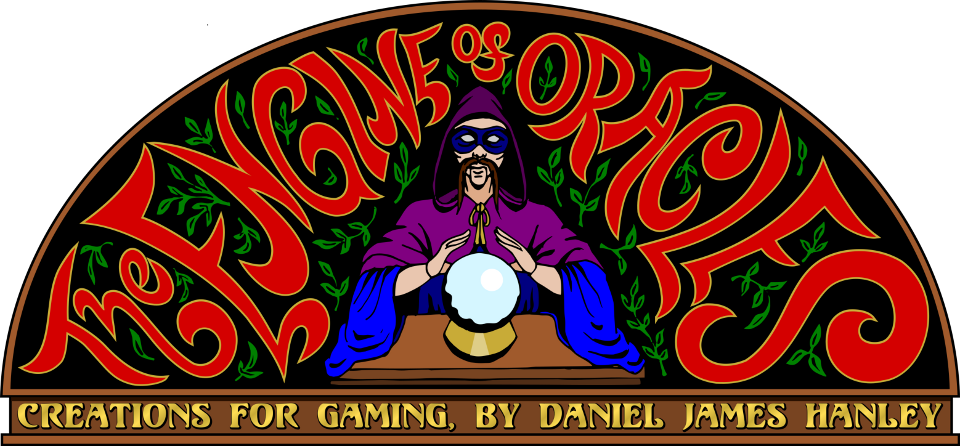Tags
This weekend I ran a game where the age range of players was between 11 and 46. A tween, a teen, and four Gen-Xers (including myself). It was the eleven-year old’s first real game as an actual player, while her 15 year old brother had already played with the group a few times. Since many young people’s first association with RPGs is “Stranger Things”, I thought it would be nice for her and her brother to experience D&D the way is was actually played in the mid-80s. So, out came my original Rules Cyclopedia! Now, I had a previous campaign world, called “Vaozum”, that I used for Old-School style games. The problem is, there are mature themes baked into that setting. So, I set myself the challenge of creating a “PG-rated” campaign world that could be easily explained to an eleven year old, but would still be interesting enough for the adults present (who were among the original “Ghastly Affair” players). I actually welcomed the chance to stretch myself creatively beyond the adult-oriented Gothic material I’ve been focused on for a few years now.
I set myself the following design goals:
- This setting is meant to be a positive, “all-ages “ one, deep enough for adults, but not dwelling on topics unsuitable for young people. I have already created an RPG specifically for adults to explore mature subjects – this is for families, mixed-age groups, and public play.
- This is a game setting, meant to be played rather than read. Everything will be minimally defined.
- Each chunk of setting info is to be presented in an impactful and easily referenced “list of ten” format that can fit on one side of a 4” x 6” index card.
- The setting is meant to be compatible with as wide a range of OSR fantasy games as possible, and to be defined loosely enough that third-party modules and adventures could be easily “slotted-in”.
- This is meant to be a fun and accessible setting, which doesn’t take itself too seriously. Humorous characters are OK.
- Every dungeon / adventure should be “winnable” with minimal bloodshed (if the players so choose), and good play should be rewarded. No “nega-dungeons”.
- It is possible to make the world a better place, and although there is still a tremendous amount of evil and danger, positive change is happening.
- Any reasonable, rules-legal concept a Player has for their character should be possible. The setting will be written to accommodate the players’ most probable desires.
- Areas are to be specifically left open to accommodate stronghold building and domain creation by Player Characters.
- I will use the “fantastic twist on a real-world historical society” conceit, so that Players can quickly grasp the setting. The unique twists on each culture must be easily remembered, so other details can be filled in as required from general knowledge, without any worry about contradicting an intricately detailed setting “canon”. Likewise, there will be many echoes of real-world legends and mythology.
I decided to use the name “Panzoasia”, which I’ve had lying around among my creative notes / half-finished work for years now.
Ten Distinguishing Qualities of Panzoasia
- There was never a Golden Age or great empire. The technology of today is much better than that of the past.
- None of the Five Peoples (Humankind, Elfkind, Dwarfkind, Halflingkind, and Gnomekind) has an older history than any of the others. Rather, they have always lived together. Humans are not less developed or sophisticated than Elves, for example.
- The current nations of Panzoasia are all relatively young – no more than a century old.
- Each realm was once colonized by large numbers of a certain kind of Monster, which left an especial impact on the realm’s modern culture and society.
- The Monsters aren’t horrible because they look and act differently, but because they cannot, or are unwilling to, live in harmony with the Five Peoples. They can’t be tolerated, because they they do not tolerate others in return. Those creatures who are willing to live with the Five Peoples as equals, however, are accepted – and not considered “Monsters”. The Monsters are invasive species that waste resources, pollute their environments, and ruin local ecologies.
- A character’s realm and culture of birth is generally more important to them than their kind of People. For example, an Elf from the realm of Corthis would generally consider herself to be primarily “Corthisian”, and only secondarily “Elven”.
- People are not seeking to expand their wealth and territory at the expense of indigenous Monsters, but engaged in an ongoing effort to win back all the wealth and territory the invasive Monsters once stole from them.
- Many of the realms are some variety of republic or elective monarchy.
- Ruined castles, ancient cities, and ancient magic items found in treasure hordes are likely to have been created by intelligent Monsters.
- There is assumed to be ongoing contact between the mundane Earth and Panzoasia, although the average inhabitant of either place is unaware of the other.
Tomorrow I’ll start posting the resulting setting…
